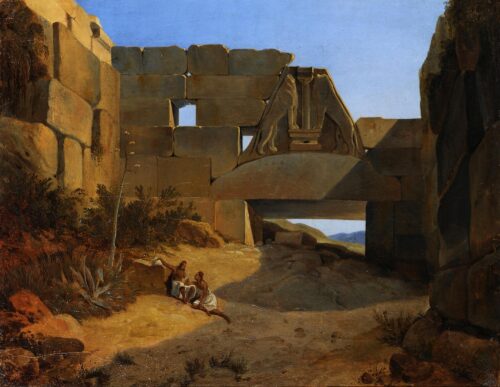
Lanza Vicenzo (1822 - 1902)
The Temple of Olympian Zeus – The Acropolis
Italian in origin, he studied painting at the Venice Academy of Fine Arts where, after his graduation, he worked for a time as an assistant to the Chair of Perspective. After the failure of the Italian revolt against the Austrians in 1848, in which he took part, he took refuge as a political exile first in Patras and two years later, Athens. For his contribution to the struggles for his homeland he was later awarded the silver decoration of the Savior and three Italian medals.
With the backing of Queen Amalia, he decorated her country residence while, at the command of Othon, he completed the iconography of the Russian church, which had been begun by Ludwig Thiersch and Nikephoros Lytras. For his work the Tsar of Russia Alexander II awarded him the Gold Medal. He was also commissioned by Othon for the painting The Army Camp at Thebes which established him as a painter, and he decorated the ceiling of the ceremonial hall of the University of Athens. From 1863 to 1901 he taught Perspective, Stage Design, Elementary Drawing and Decorative Design at the School of Arts and painting at the Evelpidon (Military Cadet) School.
In 1859 he took part in the Olympia Exhibition and participated again in 1870, winning the silver medal. At the same exhibition in 1888 he was awarded the bronze medal. He also took part in the International Exhibition at Paris in 1867 as well as exhibitions at the Parnassos Hall and was a member of many critical committees.
Employing water color for the most part, he depicted archaeological sites and monuments, establishing this as a special kind of landscape painting. In his work academic, classicistic principles coexist with a more realistic approach and colors are rendered with particular sensitivity.

The Temple of Olympian Zeus – The Acropolis

The Columns of the Temple of Olympian Zeus

Thision, ca 1860
The Temple of Aphaia, Aegina

The Acropolis, 1860

Prophet

The Lion Gate before the Excavations, 1882

We use cookies to make our site work properly, to personalize content and ads, to provide social media features and to analyze our traffic. We also share information about how you use our site with our social media, advertising and analytics partners. Read the Cookies Policy.
These cookies are necessary for the website to function and cannot be switched off in our systems. They are usually only set in response to actions made by you which amount to a request for services, such as setting your privacy preferences, logging in or filling in forms. You can set your browser to block or alert you about these cookies, but some parts of the site will not then work. These cookies do not store any personally identifiable information.
If you disable this cookie, we will not be able to save your preferences. This means that every time you visit this website you will need to enable or disable cookies again.
These cookies tell us about how you use the site and they help us to make it better. For example these cookies count the number of visitors to our website and see how visitors move around when they are using it. This helps us to improve the way our site works, for example, by ensuring that users find what they are looking for easily. Our website uses Google Analytics for statistics reporting.
Please enable Strictly Necessary Cookies first so that we can save your preferences!